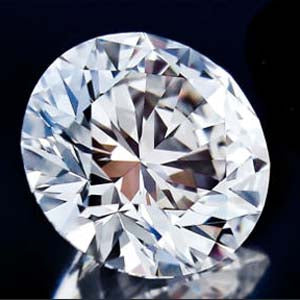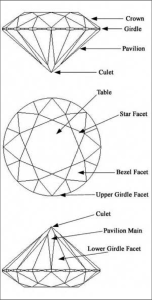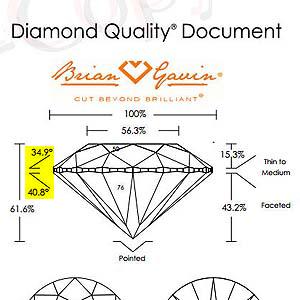
What Makes Diamond Sparkle?
Throughout history, diamond cutters have fine tuned the art of cutting a diamond so that it captures the light which enters it from above, and redirect it towards the eyes of an observer. In the early days of gem cutting, sparkle was created by simply cutting planar surfaces which are called facets, on to the surface of the diamond crystal, however over time it was understood that the angle of the facets and the facet sections played a critical part of visual performance, by intensifying the volume of light which a diamond is capable of reflecting.
The facet design of a round brilliant cut diamond:

For the purpose of this discussion, we’re going to focus on how to maximize the volume of light return and sparkle factor of a round brilliant ideal cut diamond, like those found within the Brian Gavin Signature and Brian Gavin Blue collections. The modern round brilliant cut diamond consists of 58 facets, which are divided into two primary sections known as the crown and pavilion, the crown is the upper half of the diamond, and the pavilion is the lower half of the diamond. The crown section of a diamond is further divided into a large, flat facet positioned on the top of the diamond which is known as the table facet; which is surrounded by 32 facets which comprise the bezel facets of the diamond.
The bezel region of a round brilliant cut diamond consists of eight star facets, eight kite facets, and sixteen upper girdle facets. The pavilion section of a round brilliant cut diamond is divided up into 25 facets, which consist of an eight pointed star that is made up of the pavilion main facets, and each of those is separated by two lower girdle facets, and the bottom facet of the diamond is known as the culet.
Note that some descriptions of the facet design of a modern round brilliant cut diamond will indicate that the design consists of 57 facets instead of 58, this is simply a matter of whether the author considers the bottom point of the diamond to be a facet or not, since it is technically a facet and not actually a point, we refer to it as the 58th facet of a diamond.
There are generally two categories of sparkle created by the light which travels through a diamond, and which is reflected off of the facets of a diamond, those are brilliance which is white sparkle, and dispersion which is colored sparkle, dispersion is commonly referred to as “fire” since diamonds were initially cut to respond to “fire light” which was the dominant light source of that time period.
Factors of light return in round diamonds:

While both the crown and pavilion sections of a diamond play a part in the creating light return, the pavilion angle is the primary reflective surface which dictates the volume of light return exhibited by a diamond, while the crown angle primarily dictates the type of sparkle. The proportions diagram to the left, provides us with the measurements for this 1.517 carat, G-color, VS-2 clarity, Brian Gavin Signature round diamond, the crown angle of 34.9 degrees and the pavilion angle of 40.8 degrees have been highlighted in yellow to provide you with a reference of where they appear on an AGS Diamond Quality Document, the total depth, table diameter, and girdle thickness are also provided.
It is important to realize that while the volume of light return is primarily dictated by the pavilion angle, and the balance of brilliance and dispersion are controlled by the crown angle, that the two primary sections of a round brilliant cut diamond, ultimately have to be cut to angles which complement each other if the maximum volume of light return and sparkle factor are to be achieved.
Every Brian Gavin Signature round diamond and those featured within the Brian Gavin Blue collection, are cut to what is considered to be the center or sweet spot, of the range of proportions designated for the zero ideal cut classification by the American Gem Society Laboratory (AGSL) and thus our diamonds exhibit a high volume of light return and balanced levels of brilliance and dispersion, however there are a wide variety of proportions which are considered to be “ideal cut” and we will explore those more in-depth in the next article: Standards for Ideal Cut Diamonds




















